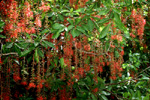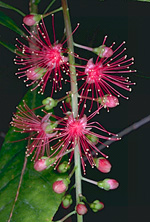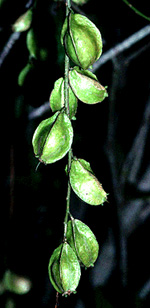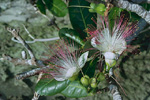 |
This is a relatively small family, most diverse in northern South America but also in Africa, Madagascar and from India to northern Australia, where two genera occur in rainforests, gallery forests along streams, monsoonal woodlands and behind tropical beaches, from the Kimberley region of Western Australia across northern Australia to south-east Queensland.
Characteristic features of the family Lecythidaceae in Australia include: - trees or large shrubs, often spreading, with large, simple, entire, alternate leaves usually clustered at the branch-tips.
- flowers bisexual, usually showy, borne in racemes or clusters terminal to shoots or sometimes on old wood
- sepals and petals 4-6, free or fused
- stamens numerous and conspicuous, the long filaments white or pink to red, fused together at the base into one or more rings
- ovary inferior, developing into a large, often angular nut
Description
Evergreen trees or shrubs. Internal secretions not obvious.
Plants glabrous or with simple, non-glandular, unicellular hairs. Leaves
alternate and spiral, or whorled, or pseudo-whorled, petiolate. Stipules
absent, or present and distinct and free from the petiole, falling off
early. Lamina simple, symmetric, lanceolate, ovate, oblanceolate, oblong
or spathulate; base cuneate or attenuate; margins entire, crenate, dentate
or serrate, ±flat; venation pinnate, with the midrib conspicuous,
and the tertiary venation reticulate; surfaces not punctate; herbaceous
or leathery. All the flowers bisexual. Inflorescences terminal, axillary,
cauliflorous or ramiflorous, consisting of spikes, racemes or solitary
flowers. Bracts and bracteoles present. Pollination by insects or bats.
Flowers sessile or stalked. Floral disc present. Perianth regular, of
2 dissimilar whorls or of 1 whorl only, rarely all whorls ±similar,
imbricate or valvate in bud. Calyx segments free or fused, with (2) 46
sepals or lobes; calyx cup-shaped or bell-shaped, herbaceous, papery or
membranous. Corolla segments free, with 46 petals, alternating with the
sepals or calyx lobes, cream, yellow, red or pink, without contrasting
markings, membranous; claws absent; lobes ±entire. Fertile stamens
10numerous, not clearly correlated with the sepals or calyx lobes, at
least partly fused to the corolla, free of the ovary and style, grouped
or fused into bundles or fused by their filaments into an open or closed
tube, all ±equal. Staminodes present. Anthers basifixed, not versatile,
opening by longitudinal slits, 2-celled. Ovary part-inferior or inferior.
Carpels 24, fused; ovary with 24 locules. Style terminal, single and
unbranched, or rarely single and branched above. Ovules (1) 26 per
locule, sessile; placentation axile. Fruit a fleshy, indehiscent berry;
the perianth on the maturing fruit deciduous. Disseminule macro-surface
featureless or costate; micro-surface ±smooth, green, dull. Seeds
16 per fruit. Aril absent. Cotyledons 0 or 2. Embryo straight or coiled.
(Note: this description has been generated from the coded data compiled for the key. Any errors in the key data will be reflected in the descriptions.)
A treatment of the family Lecythidaceae has been published in:
Flora of Australia 8: 16.
Australian genera of Lecythidaceae (as recognised for the Flora of Australia)
Barringtonia
Planchonia

|
  |

Barringtonia acutangula (flowering branch)
Photo: G.Sankowski © Zodiac Publications

Barringtonia acutangula (flowers)
Photo: M.Fagg © ANBG

Barringtonia acutangula (fruits)
Photo: G.Sankowski © Zodiac Publications

Barringtonia asiatica (flowers)
Photo: M.Fagg © M.Fagg

|
 |
|